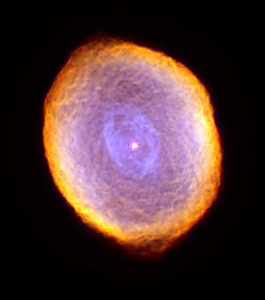Nebula, << NEHB yuh luh, >> is a cloud of dust particles and gases in space. The term nebula comes from the Latin word for cloud. Early astronomers also used the term for distant galaxies outside Earth’s galaxy, the Milky Way. Such galaxies, called extragalactic nebulae, looked like hazy patches of light among the stars. But modern telescopes showed that extragalactic nebulae are actually systems of stars similar to the Milky Way.
Today, most astronomers use the term nebulae only for the clouds of dust and gases in the Milky Way and other galaxies. They classify these masses into two general types: diffuse nebulae and planetary nebulae. Both types are also called gaseous nebulae.

Diffuse nebulae
are the larger of the two types. Some diffuse nebulae contain enough dust and gases to form as many as 100,000 stars the size of the sun.
A diffuse nebula may occur near an extremely hot, bright star. The intense ultraviolet light from the star energizes the gas atoms of the nebula and enables the mass to emit light. A diffuse nebula of this kind is called an emission nebula.
Loading the player...Crab Nebula
Astronomers believe some emission nebulae are places where new stars are forming. Gravity causes a portion of a nebula’s dust and gases to contract into a much smaller, denser mass. Pressure and temperature build up within the mass of dust and gases as contraction continues for millions of years. In time, the mass becomes hot enough to shine—and forms a new star.
Loading the player...X rays from the Crab Nebula
A diffuse nebula also may occur near a cool star. In this case, the ultraviolet light from the star is too weak to make the nebula’s gas atoms give off light. But the dust particles in the diffuse nebula reflect the starlight. Astronomers refer to this kind of diffuse nebula as a reflection nebula.
If a diffuse nebula occurs in an area that has no nearby stars, it neither emits nor reflects enough light to be visible. In fact, its dust particles blot out the light from the stars behind them. Astronomers call such a diffuse nebula a dark nebula.
Planetary nebulae
are ball-like clouds of dust and gases that surround certain stars. They form when a star begins to collapse and throw off the outer layers of its atmosphere. When viewed through a small telescope, this type of nebula appears to have a flat, rounded surface like that of a planet.

